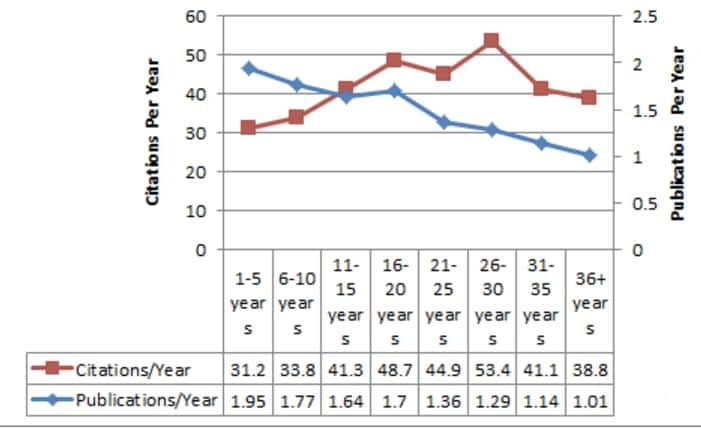The Volokh Conspiracy
Mostly law professors | Sometimes contrarian | Often libertarian | Always independent
Law faculty productivity at different career stages
My friend and co-blogger Jonathan Adler recently flagged a new article on faculty productivity and citation rates, and I wanted to draw attention to some interesting information found inside it. The author, James Phillips, collected data on publication and citation rates for faculty at different stages of their careers. Although Phillips presents the data divided into different ideological groups, I contacted him and asked him to combine the numbers to include all professors.
He generously agreed, and he sent me this graph:

The graph shows the average productivity (in articles per year) and average citation rates (in journal citations per year) of the different cohorts among the faculty at the "top 16" schools.
The results aren't particularly surprising. But I think they are still interesting. Productivity appears to be on a fairly even slope downward over time, with the more experienced professors writing less. On the other hand, citation rates seem to have more of a hill shape. They go steadily up at first, reach their peak for a while, and then drop.
It's important to note that the graph does not necessarily show productivity declining over the course of careers. Phillips calculated productivity and citations rates of different groups of faculty members rather than tracking faculty members over time (as I did for one law school in this post last year). It's possible that the numbers merely reflect steadily rising scholarly expectations of top law schools over the years. Productivity may be higher for younger professors because they were hired at a time when higher productivity was expected. Remember Justice Stephen Breyer's recollection of tenure standards at Harvard in the late 1960s. At the time, it was a big deal that Harvard required professors to write a single article for tenure.
It's hard to know which interpretation, or what mix, is more accurate. But I thought the information was worth flagging for interested readers.
Show Comments (0)